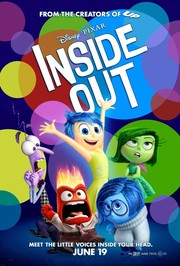Coping With Children’s Sadness During Divorce
 If you have not seen the movie Inside Out, I highly recommend it. It’s not just for kids. In fact, it’s probably too complicated for kids under age 10, but it sure packs a powerful message for adults.
If you have not seen the movie Inside Out, I highly recommend it. It’s not just for kids. In fact, it’s probably too complicated for kids under age 10, but it sure packs a powerful message for adults.
Inside Out is an animated Disney movie that brilliantly crafts a balance between joy and sadness. The movie features a girl, Riley, and personifies five emotions in her head. With amazing creativity, the movie illustrates the tumult and conflicting emotions causes by the stresses of growing up. In Riley’s case, her family moves from the Midwest to San Francisco, and it is a very challenging adjustment.
The overriding message of the movie is that there is a place for children’s sadness in life. While “Joy” tries valiantly to cancel out “Sadness” and jolly Riley back to herself, in the end, Joy and Sadness realize that Riley needs both of them so she can grow through her challenges.
Coping With Children’s Sadness During Your Divorce
It seems that the same message is essential for children who are experiencing the separation of their parents. Many parents wonder, “How will I know when or if my children need professional counseling in dealing with sadness?” The road of life is filled with challenges, as we all know. Having a sounding board or a “professional companion” along the way is a gift to yourself and your children. Creating a counseling relationship that feels safe and accessible lets your children learn that they can use lots of resources to help themselves along the way of life.
A good way of encouraging these relationships is to discuss and be honest about how useful therapy has been to you during your own challenging times. Everything needs a tune-up occasionally; cars, household furnaces, even our trusted computers all need attention at times. People often need the same thing.
How Therapy Can Help Your Children Cope with Your Divorce
Some of the most valuable outcomes of therapy are:
- A virus in your computer: Difficult times can trigger previous challenges or feelings in a child. A therapist can help “delete” the connection and avoid letting it warp future experiences.
- Pay me now or pay me later: When things remain unresolved, future challenges (and there are always challenges) can feel two or three times more painful than necessary.
- Shortcut to happiness: Spending 6-12 months now with a therapist may preclude a lifetime of shadowy feelings that keep cropping up.
- Message to the kids: Creating a therapy opportunity is a subte message to your children that you love them and care about their well-being.
Guidelines to Help You Decide When Your Child May Need Therapy
Sometimes we avoid check-ups and live with minor aches and pains. Sometimes it’s hard to tell when something just needs time to heal or needs an intervention. As a parent, you have to calibrate the difference between sad and adjusting, and sad and really struggling. It’s the difference between your child’s 100-degree temperature when you might wait, or a 104-degree temperature when you are definitely calling the doctor.
Here are some guidelines to let you know when your child may need therapy:
- Has your child changed his/her behavior? For example, your quiet child becomes a chatterbox or your social child becomes withdrawn. A change in behavior may be a reaction to trauma.
- Are they increasingly critical of their friends or siblings? They may be a sign they do not think very well of themselves.
- Are the kids hanging around with different kids? A child’s choice of friends often reflects their self-image.
- When kids lash out, cry more, or try to push you away, ironically they are looking for reassurance and need help accepting it.
- Persistent physical complaints and trouble sleeping or gaining or losing weight with no medical basis.
- The onset of lying or phobias or becoming accident-prone is a cry for attention.
- A change in school interest or performance and wanting to do more (or less) than the usual extracurricular activities.
- Much more curiosity and questioning about your activities, where you are and what you are doing.
- Teachers and friends are gently expressing concern.
- The child’s general hygiene changes, such as biting nails, hand and hair washing, or care of clothes.
While getting therapy is important, the type of therapy matters also. Younger children, perhaps up to first or second grade and certainly preschoolers, might respond best to art, music, or play therapy that allows then to express themselves indirectly.
Older children can generally handle more cognitive approaches; often peer sessions are very useful. There are several area school districts (Rochester NY metro area) that offer in-school group sessions that might be a very good transition. (Check with your school if you live in a different region.)
A highly recommended book to help guide parents is Straight Talk About Your Child’s Mental Health (aff) by Stephen Faraone. As noted on the book’s cover:
Parents reach for dog-eared copies of Dr. Spock when their child has a rash or the flu, but when “moodiness” lingers or worrisome behavior problems grow, they have nowhere to turn for answers or reassurance. Now, in this compassionate resource, prominent Harvard researcher Dr. Stephen V. Faraone gives parents the tools they need to look clearly at how a child is feeling, thinking, and behaving and make wise decisions about when to call for professional help.
Resources
Photo credit: Disney Movies
